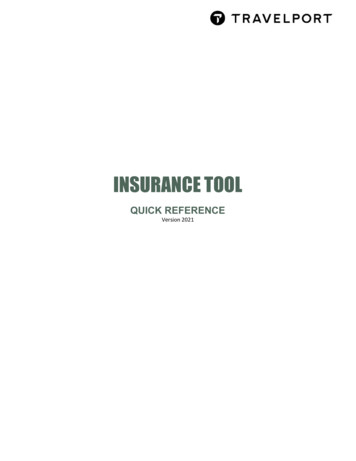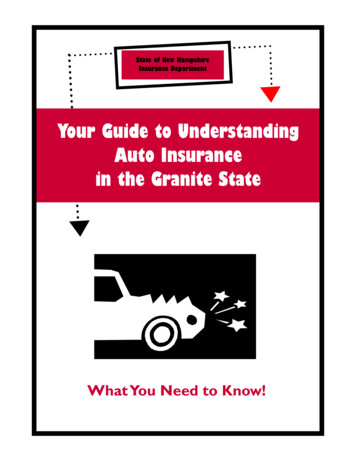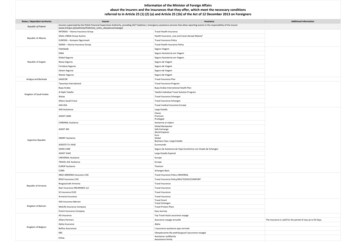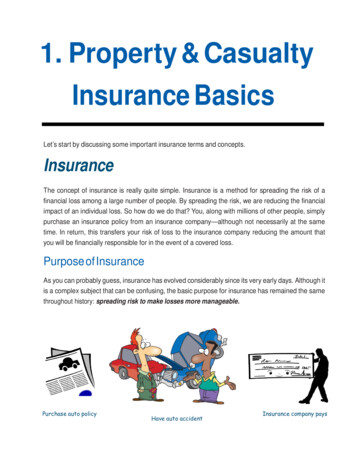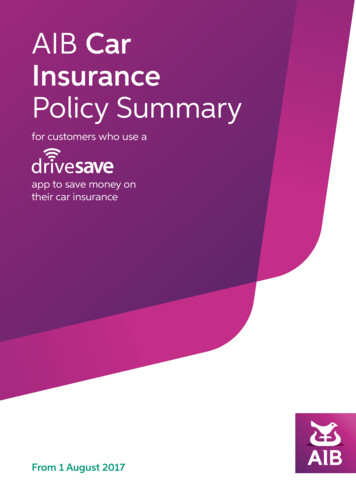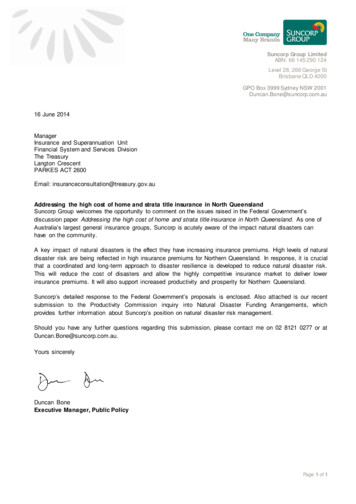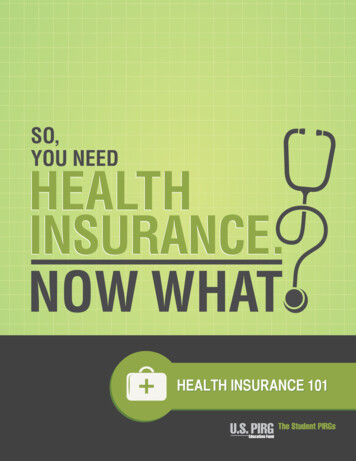
Transcription
Health insurance 101
Know the facts.Knowing the facts can make all the differencewhen it comes to health insurance. To makethe most of new choices, protections and financial help, you need good information. Thisguide can help you find quality coverage that won’t break the bank.Dealing with health insurance as a young person can be tricky. You might be uninsured,or could be about to lose coverage through your parents’ or college’s health plan, butaren’t sure what to do next. Looking for insurance raises all kinds of questions:Can I afford it? What’s covered if I get sick?Where do I look to find a good plan?AuthorsLaura EthertonMike RussoThe authors bear responsibility for any factual errors. The views expressed in thisguide are those of the authors, and do not necessarily reflect the views of our funders.About U.S. PIRG Education FundWith public debate around important issues often dominated by special interests pursuing their own narrow agendas, U.S. PIRGEducation Fund offers an independent voice that works on behalf of the public interest. U.S. PIRG Education Fund, a 501(c)(3)organization, works to protect consumers and promote good government. We investigate problems, craft solutions, educate thepublic, and offer Americans meaningful opportunities for civic participation.www.uspirgedfund.orgFor more information about U.S. PIRG Education Fund or foradditional copies of this guide, please visit us online.
Get covered.Let’s face it—not getting covered can be a huge mistake.An accident or a serious illness can mean getting stuckwith huge medical debt or going broke.But there’s good news. With the right facts and resources, you can make intelligent andinformed health insurance choices. And, with the new health insurance marketplace, it’seasier to compare plans and find coverage that fits your budget and helps keep you healthy.ccSome Rights ReservedU.S. PIRG Education Fund issues this guide under a Creative Commons Attribution-NonCommercial-NoDerivs 3.0 UnportedLicense. You are free to copy, distribute, or display the work for noncommercial purposes, with attribution. For more informationabout this Creative Commons license, visit: creativecommons.org/licenses/by-nc-nd/3.0/The Student PIRGsThis publication was made possible in part through generous supportfrom the Robert Wood Johnson Foundation.
health insurance 101contentsWhy get covered?4If you get sick or are injured in anaccident, the cost of treating you canquickly exceed your ability to pay.A single visit to the emergency room foran unexpected health situation can runinto the thousands or tens of thousandsof dollars.What’s changing5 What are my Options? Where to Lookfor Health InsuranceParents’ PlanCoverage Through Your JobStudent Health PlanThe Health Insurance MarketplaceMedicaid And The Children’s HealthInsurance Program (CHIP)7What Plan is Right for me? Makingthe Most out of the MarketplaceKnow What’s CoveredFind Out About Financial HelpWhat Are The Costs?Compare Plans Side-By-SideWhat Health Care Providers Can I See?How Does The Quality Stack Up?12 What are my Rights? Getting a FairShake from your Insurance Company13 Health Insurance BasicsPaying For Insurance And Medical Care: Key TermsMain Types Of Health Coverage3So, for decades Americans havebought health insurance policies thatensure they can get basic health carewhen they need it without paying foreverything out of pocket. Every month,individuals—and in many cases theiremployers, too—pay a certain amountof money to an insurance company topurchase coverage (also called a healthinsurance plan or policy). That coveragemeans that if you get sick or have anaccident, the insurer agrees to coversome or most of the expenses.
What’s changingThe main pieces of the Affordable Care Act, or“Obamacare,” begin taking effect in the fall of 2013.Here are some of the highlights:1 New OptionsAs of October 2013, the new Health Insurance Marketplacewill help you compare options, find out about financial help,and sign up for coverage. Find out more at Healthcare.gov or bycalling 1-800-318-2596 (TTY: 1-855-889-4325).2 No More Pre-Existing Condition DenialsEffective January 2014, health insurance companies can no longer denycoverage or hike your rates due to having a pre-existing health condition.3 An End to Gender DiscriminationCharging women more than men for coverage is now against the law.4Financial help kicks inIf your income is less than about 46,000 for an individual, or 94,000 for a family of four,you can get help paying for the cost of coverage if you buy it on the marketplace.In many states, citizens and lawfully admitted immigrants earning less than about 16,000a year for a single person and 32,500 for a family of four can get free or low-cost coveragethrough the Medicaid program.5 But You’ll Have to Do Your PartTo keep health insurance premiums from rising more than they should, everyone needs topull his or her weight and get covered. If people only buy coverage when they get sick, itdrives up costs for everyone. So, as of January 2014, all who can afford it must buy coverageor pay a penalty.For a complete timeline and outline of changesunder the health care law, go tohhs.gov/healthcare Information and resources:Healthcare.gov4
What are my Options?Where to Look for Health InsuranceGetting coverage for the first time can beconfusing. But with new options and bettertools to compare plans, you’ve got a goodshot at success. Here’s where to look, whetheryou are finding coverage for the first time, orif your situation has changed and you needto get covered again.Parents’ PlanIf you want decent health coverage and youare not yet 26, your first call should be toyour parent or guardian. The Affordable CareAct requires most health insurance plans toallow you onto your parent’s or guardian’scoverage until your 26th birthday as long asthey have a family plan.If your parents are already carrying a familyplan, they will not be required to pay anything extra to cover you. If they have a planthat only covers themselves or themselvesand a spouse, they will have to purchasea family plan at the next open enrollmentperiod. Even then, the cost will likely be farless than paying for their plan and a separatepolicy for you.To determine when and whether you may beeligible for your parents’ coverage, contactthe insurance company.5Coverage Through Your JobMore than half of all Americans receive theirhealth coverage through their employerprovided plan, and you may have a chance tobe one of them.So when considering a job, find out about thehealth insurance benefits. And if you have ajob now, stop by your employer’s human resources or personnel office to see what healthinsurance benefits are available, if any, andfind out how to sign up.Student Health PlanMany colleges and universities offer healthinsurance plans to their students. Generally, these plans are available only to students, but some allow students taking timeoff from school to maintain their coverage,or keep their coverage for a limited periodof time after graduation. Find out aboutplans your school might offer at the studenthealth office.One thing to watch out for is that often,these plans are designed for healthy peoplewho don’t need much care. See more underthe “What Are The Costs?” section for tipson figuring out what plan is right for you.
The Health Insurance MarketplaceShopping for health insurance can bechallenging. But with the new online healthinsurance marketplace, chances are gettingbetter that you can find a good plan that fitsyour budget.At the marketplace, you can see all youroptions and enroll. Information aboutinsurance plans is written in plain language,and all the plans have to cover a goodset of benefits—including doctor visits,hospitalizations, maternity care, emergencyroom care, prescription drugs and more. Noinsurance plan can deny you or charge youmore because of a pre-existing condition.If you buy a plan on the marketplace, youmight qualify for financial help to makecoverage more affordable.Find out more at Healthcare.govor by calling 1-800-318-2596(TTY: 1-855-889-4325).Medicaidand the Children’sHealth InsuranceProgram (CHIP)Medicaid is a governmenthealth care program that provides insurancefor some low-income people, families andchildren, pregnant women, the elderly, andpeople with disabilities. The programs vary abit depending on what state you live in.Most states are expanding Medicaid in 2014so that it can cover people with higher incomes than before. If you didn’t qualify before, you might now. As of October 2013, youcan find out if you qualify for Medicaid byfilling out an application at the Health Insurance Marketplace (see above).If you’re 18 or younger, or have children ofyour own, you may want to check out theChildren’s Health Insurance Program (CHIP)in your state. CHIP provides low-cost healthcoverage to children in families that earn toomuch to qualify for Medicaid.In the section “Making The Most Out Of The Marketplace,”you’ll find more information on how it works and tips forcomparing plans.76
What Plan is Right for me?Making theFind Out About Financial HelpAt the health insurance marketplace, differentplans’ costs and benefits are written in plainlanguage. And you’ll be able to compare themside-by-side.In addition, all health insurance plans offered in themarketplace have to offer the same set of core benefits, called “essential benefits,” and some may offeradditional benefits. These core benefits include: Hospital outpatient and inpatient careEmergency servicesMaternity and newborn careMental health and substance use disorderservices, including behavioral health treatmentsuch as counselingPrescription drugsServices and devices to help people withinjuries, disabilities, or chronic conditions gain orrecover mental and physical skillsPreventive and wellness servicesChronic disease managementPediatric servicesThe insurance plans must cover a set of preventive services at no cost to you. See the full list ofgeneral preventive services, preventive care forwomen, and preventive care for children efits.7Between college loans, living expenses andcredit card debt, it can be tough to find a wayto pay for health insurance. But if you have anaccident or get a serious illness the last thingyou need is medical debt on top of everythingelse. The good news is that there is financialhelp available to help you make the most ofthe new health insurance marketplace.Many people are able to pay on a sliding scale,or even qualify for free or very low-cost coverage. To find out what savings you qualify for,fill out the application at the marketplace. Ifyou run into questions, remember that youcan always get help online, on the phone, andin-person.What are the Costs?Once you’ve narrowed down your optionsto several plans, take a look at the specificcosts of each plan. It’s important to consider not only the monthly premium, butthe potential out-of-pocket costs as well.That way, you can get a sense of the total cost you might face over the course ofa year. The specific out-of-pocket costs tolook at are co-pays, deductibles, and coinsurance. You’ll also want to make specialnote of the out-of-pocket maximum.
e most out of the marketplaceThere are three kinds of financial help available, depending on your income and family size.Lower monthly health care premiumsYou may qualify for a subsidy that reduces yourmonthly premium amount. The amount yousave off your premium depends on your incomeand family size.Many people will qualify for some level ofthis tax credit. For example, you’ll see lowerpremiums if your income is less than about 46,000 for an individual, 62,000 for a familyof two, or 94,000 for a family of four.Lower out-of-pocket costsYou may also be able to pay less for “out-ofpocket costs” like co-pays and deductibles,Here’s a simple formula to see what you could have topay in a year, in a worst-case scenario if you have amajor illness or accident:(Monthly Premium x 12 months) Out-of-Pocket Maximum Worst-case scenario yearly costFor definitions of these terms see page 13.which you pay for at the time you receive medical care. Many people will qualify for theselower costs.Free or low-cost coverageYou, or your children if you have any, mayqualify for Medicaid or the Children’s HealthInsurance Program (CHIP)—two programs thatwe outlined earlier in this guide. When youfill out your application at the marketplace,you’ll find out if you and your family qualifyfor Medicaid or CHIP.
Making the most out of the marketplaceCompare Plans Side-by-sideIn the marketplace, you can compare plansbased on a number of factors. You can look atpremiums and out-of-pocket costs, and seewhich health care providers and hospitals areavailable in each plan. In some states, you canalready compare quality ratings of the differentplans, and in others the quality rating will beadded in future years.Bronze, Silver, Gold and PlatinumIn the past, it was practically impossible to compare insurance plans “apples to apples,” with seemingly infinite combinations of premiums, co-pays,deductibles, annual coverage limits, co-insurancelevels, and out-of-pocket maximum amounts.In the marketplace, you can take advantage of thefact that the insurance plans have been neatlysorted into categories so you can compare themmore easily. The categories are Bronze, Silver,Gold and Platinum.The categories are not based on the quality ofA note oncatastrophic plansIn addition to the Bronze, Silver, Gold andPlatinum plans, if you’re under 30, or if youotherwise qualify by having a limited income thatmakes other coverage unaffordable, you may buya “catastrophic plan.”These plans have lower premiums and they coverpreventive care and three primary care visits peryear with no co-pay. But if you need more care,9care, or the amount of care you can receive. Theyare based on how much of your medical costs youpay, and how much the insurance company pays.As a general rule, the higher the monthly premium, the lower your out-of-pocket costs will be ifyou need care: Platinum plans will generally havethe highest premiums, but if you need care, you’llpay less in out-of pocket costs. Bronze plans willgenerally have lower premiums, but you’ll paymore in out-of-pocket costs if you need care.If you think you’ll need a lot of care in the yearahead, it might make sense to pay a somewhathigher monthly premium and get a Gold or Platinum plan, and know that you’ll face lower outof-pocket costs when you receive care.On the other hand, if you don’t think you’ll needmuch care, you may want to pay a lower monthlypremium and get a Bronze or Silver plan, and riskthe chance that you might get hit with higherout-of-pocket costs if you have an unexpectedillness or accident.you’ll face significant out-of-pocket costs. That’sbecause a catastrophic plan requires you to pay100 percent of the cost of your medical careuntil you’ve paid a certain amount, often severalthousand dollars.These plans protect you from worst-case scenarioswhere you’d otherwise be on the hook for medicalcare costing tens or hundreds of thousands ofdollars, hence the name “catastrophic.” It’s alsoimportant to note that if you choose a catastrophicplan, you won’t be able to qualify for financial helpthrough the marketplace.
What Health CareProviders Can I See?When you are comparing plans, take advantage of the fact that each plan willinclude a list of health care providers.This is the plan’s “provider network.”If you visit a provider that isn’t part ofthis network, you’ll pay higher costs, soif you already have a doctor, check to seeif they are included in the plan you areconsidering.Different types of insurance plans havedifferent rules about whether you canget care outside of their provider network and still get the cost covered, andat what cost:HMOHealth MaintenanceOrganizationThese plans typically limit coverage totheir provider network. You may be on thehook for the full cost of care if you use ahealth provider outside of the network. Inaddition, if you want to see a specialist inthe network, you may need to get a referral from your primary care provider.PPoPreferred ProviderOrganizationA PPO covers care from providers bothinside and outside the network. However,if you use a provider outside the network,you’ll pay higher out-of-pocket costs forthat care. You can see a specialist insideor outside the network without a referral.How Does the Quality Stack Up?Unfortunately, when it comes to health care, cost rarely tells youanything about quality. While few things are more important thanyour health, there has been too little information about healthcare safety and quality available for consumers.Now, that is beginning to change. In many states, the new marketplace includes tools to help you compare the quality of insuranceplans and their provider networks. In other states, this informationwill become available in future years.Great ResourcesHealth Plan Report Card: Check out quality ratingsof the health insurance plans you are considering and comparethem head-to-head on things like how well they help people stayhealthy, get better when they’re sick, and manage chronic illness.This site is run by the National Committee for Quality Assurance.Check it out at reportcard.ncqa.org/plan.Physician Compare: Find out which physicians andother health care providers take part in several important qualityprograms. In the future it will also include quality ratings andinformation about participation in other quality programs. The siteis run by Medicare.Check it out at medicare.gov/physiciancompare.Hospital Compare: Find out how hospitals in your arearate on a variety of quality, safety, and patient satisfactionmeasures, and how they compare to the average across thestate and across the nation. This is also part of the official U.S.government site for Medicare.Check it out at medicare.gov/hospitalcompare.10
Making the most out of the marketplaceGet Expert HelpComparing Plansand Signing UpAt the Health Insurance Marketplace,you can apply for coverage online, bymail, or in-person, and get help from aspecially trained person to guide youthrough the process.Online: Healthcare.govIn person: People areavailable in communitiesacross the state to helpyou apply and understandyour options. Find them by visiting thewebsite or calling the number below.Toll-free: (800) 318-2596TTY: (855) 889-4325Learn more and stay in touchOur organization and many others have worked for yearsto lower the cost of health care and give consumersbetter choices and more control. The new options andtools consumers now have, including the health insurancemarketplaces, all mark a key milestone in this effort.But we still have more progress to make if we’re to reallymake health care work across America. Going forward, we’llmake the case for ongoing improvements to ensure the11new marketplaces meet their potential to boost competition,reduce costs and improve quality. And we’ll work to strengthenother key consumer protections aimed at cutting waste andimproving care.Find out more about our work at uspirgedfund.org. Andplease tell us about your experience finding health insuranceby using the “contact us” feature on the website. We want tohear how it went, so we can keep working to make it better.
What are my rights?Getting a fair shake from your insurance companyWhether you’re just beginning the search for health insurance or already have coverage, you shouldbe aware of your rights and the rules insurance companies must abide by under the law.1The right to stay on your parents’ familyhealth insurance plan until age 26.2The right to coverage that cannot bedropped when an unexpected condition oraccident makes your care expensive.34The right to an appeal if coverage forneeded care is denied by your insurer.The right to information about the costof insurance and the quality of insurancebenefits so that you can choose the planthat works best for you.5The right to choose your own primary caredoctor or pediatrician and to see an OB/GYN without a referral.6The right to emergency care when andwhere you need it without huge out-ofnetwork costs.7The right to a rebate if your insurer spendsless than 80% of premium dollars on care.8The right to free preventive care to keep youhealthy and your health care costs down.9The right to get covered, even if you have apre-existing health condition.If your insurer fails to respect your rights, contact the state insurance commissioner. Go towww.naic.org/documents/members membershiplist.pdf for details on how to report insurancecompany abuses. You can also contact the federal Department of Health and Human Services athealthinsurance@hhs.gov.Get involved in the campaignYour friends likely have the same questions as you about health insurance.Many people remain largely unaware ofthe new coverage options.There are internships and volunteer opportunities availablethroughout the year to work on the Health Insurance 101campaign.To learn about internships with The Student PIRGs, visit:You can help make a difference on thisissue by educating your friends and peers about these tipsand resources available to them.studentpirgs.org/internships1213
Health Insurance BasicsPaying for Insurance andMedical Care: Key termsPremiumThe amount chargedto keep you on yourinsurance plan, usually quoted as amonthly price. For employer-providedinsurance, the premium is usually sharedbetween the employer and the employee.Cost-Sharing (or out-of-pocket costs)In addition to premiums, many plans useother ways to share costs for medical expenses between the insurance companyand the patient. There are three types ofcost sharing: “co-pays,” “deductibles,”and “co-insurance”:Co-Pay (or co-payment)A flat amount you pay when you get medical care. For example, you may have a 20co-pay for a visit to a primary care doctorand a 25 co-pay for prescriptions.DeductibleThe amount which you must pay yourself before your insurance covers any13costs. For example, a plan with a 1,000deductible would require you to pay foryour first 1,000 of medical care eachyear before the insurance companywould cover any portion of the cost. Office visits are usually exempt from thedeductible, meaning you would just paythe co-pay amount.Co-InsuranceThis cost-sharing method usually kicks inafter you hit your deductible. It requires apatient to pick up a certain percentage ofthe cost of a procedure while the plan covers the rest. For example, a plan with 80/20hospital co-insurance will cover 80% of thecost of your hospital stay, and 20% of thecosts will be your responsibility.Out-of-Pocket MaximumThe maximum amount you could have topay in a year in out-of-pocket costs. Onceyou’ve paid this amount in the year, yourinsurance covers 100% of the costs of anyadditional medical care.
Main types ofhealth coverageGroup CoverageHealth insurance plans provided by acompany, government agency, or union.Rather than covering one person or onefamily, these plans cover large groups ofpeople. In most cases, employers pay aportion of the cost of the premium.Individual CoverageThis is coverage bought by the individual, not the employer, for him or herselfand his or her family. Effective in 2014,many people with individual coveragewill qualify for financial help payingfor premiums and out-of-pocket costs.Public CoverageCoverage paid for with federal and/orstate dollars.public coverageMedicaid: Government health care paid for with stateand federal money that provides health coverage forsome low-income people, families and children, pregnantwomen, the elderly, and people with disabilities. Theprograms follow federal guidelines, but vary depending onwhat state you live in.Children’s Health Insurance Program (CHIP):Similar to Medicaid, this is a government program that provides low-cost health coverage to children in families thatearn too much for Medicaid.Medicare: A federal government program that provideshealth insurance to people over age 65 and to some peoplewith disabilities.514
Design: Cecily Anderson, Anagramist.com. Photography:Nicole BarkerThe Student PIRGsCheck out the new Health Insurance Marketplace:Healthcare.gov
tHe HealtH insurance marKetPlace Shopping for health insurance can be challenging. But with the new online health insurance marketplace, chances are getting better that you can find a good plan that fits your budget. At the marketplace, you can see all your options and enroll. Information about insurance plans is written in plain language,
